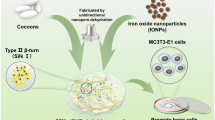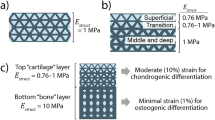Abstract
This study fabricated homogeneous gelatin–strontium substituted calcium phosphate composites via coprecipitation in a gelatin solution. Unidirectional porous scaffolds with an oriented microtubular structure were then manufactured using freeze–drying technology. The resulting structure and pore alignment were determined using scanning electron microscopy. The pore size were in the range of 200–400 μm, which is considered ideal for the engineering of bone tissue. The scaffolds were further characterized using energy dispersive spectroscopy, Fourier transform infrared spectroscopy, and X-ray diffraction. Hydroxyapatite was the main calcium phosphate compound in the scaffolds, with strontium incorporated into the crystal structure. The porosity of the scaffolds decreased with increasing concentration of calcium-phosphate. The compressive strength in the longitudinal direction was two to threefold higher than that observed in the transverse direction. Our results demonstrate that the composite scaffolds degraded by approximately 20 % after 5 weeks. Additionally, in vitro results reveal that the addition of strontium significantly increased human osteoblastic cells proliferation. Scaffolds containing strontium with a Sr-CaP/(gelatin + Sr-CaP) ratio of 50 % provided the most suitable environment for cell proliferation, particularly under dynamic culture conditions. This study demonstrates the considerable potential of composite scaffolds composed of gelatin–strontium-substituted calcium phosphate for applications in bone tissue engineering.












Similar content being viewed by others
References
Yang S, Leong KF, Du Z, Chua CK. The design of scaffolds for use in tissue engineering. Part I. Traditional factors. Tissue Eng. 2001;7(6):679–89. doi:10.1089/107632701753337645.
Parikh SN. Bone graft substitutes: past, present, future. J Postgrad Med. 2002;48(2):142–8.
Sasaki N, Sudoh Y. X-ray pole figure analysis of apatite crystals and collagen molecules in bone. Calcif Tissue Int. 1997;60(4):361–7.
Lee SB, Jeon HW, Lee YW, Lee YM, Song KW, Park MH, et al. Bio-artificial skin composed of gelatin and (1 – >3), (1 – >6)-beta-glucan. Biomaterials. 2003;24(14):2503–11.
Kuijpers AJ, van Wachem PB, van Luyn MJ, Plantinga JA, Engbers GH, Krijgsveld J, et al. In vivo compatibility and degradation of crosslinked gelatin gels incorporated in knitted Dacron. J Biomed Mater Res. 2000;51(1):136–45.
Yung CW, Wu LQ, Tullman JA, Payne GF, Bentley WE, Barbari TA. Transglutaminase crosslinked gelatin as a tissue engineering scaffold. J Biomed Mater Res Part A. 2007;83(4):1039–46. doi:10.1002/jbm.a.31431.
Sun L, Berndt CC, Gross KA, Kucuk A. Material fundamentals and clinical performance of plasma-sprayed hydroxyapatite coatings: a review. J Biomed Mater Res. 2001;58(5):570–92.
Song J, Xu J, Filion T, Saiz E, Tomsia AP, Lian JB, et al. Elastomeric high-mineral content hydrogel-hydroxyapatite composites for orthopedic applications. J Biomed Mater Res Part A. 2009;89(4):1098–107. doi:10.1002/jbm.a.32110.
Kim HW, Kim HE, Salih V. Stimulation of osteoblast responses to biomimetic nanocomposites of gelatin-hydroxyapatite for tissue engineering scaffolds. Biomaterials. 2005;26(25):5221–30. doi:10.1016/j.biomaterials.2005.01.047.
Kim HW, Knowles JC, Kim HE. Porous scaffolds of gelatin-hydroxyapatite nanocomposites obtained by biomimetic approach: characterization and antibiotic drug release. J Biomed Mater Res B Appl Biomater. 2005;74(2):686–98. doi:10.1002/jbm.b.30236.
Okayama S, Akao M, Nakamura S, Shin Y, Higashikata M, Aoki H. The mechanical properties and solubility of strontium-substituted hydroxyapatite. Bio-Med Mater Eng. 1991;1(1):11–7.
Kim TN, Feng QL, Kim JO, Wu J, Wang H, Chen GC, et al. Antimicrobial effects of metal ions (Ag+, Cu2+, Zn2+) in hydroxyapatite. J Mater Sci. 1998;9(3):129–34.
Botelho CM, Brooks RA, Best SM, Lopes MA, Santos JD, Rushton N, et al. Human osteoblast response to silicon-substituted hydroxyapatite. J Biomed Mater Res Part A. 2006;79(3):723–30. doi:10.1002/jbm.a.30806.
Landi E, Logroscino G, Proietti L, Tampieri A, Sandri M, Sprio S. Biomimetic Mg-substituted hydroxyapatite: from synthesis to in vivo behaviour. J Mater Sci. 2008;19(1):239–47. doi:10.1007/s10856-006-0032-y.
Christoffersen J, Christoffersen MR, Kolthoff N, Barenholdt O. Effects of strontium ions on growth and dissolution of hydroxyapatite and on bone mineral detection. Bone. 1997;20(1):47–54.
Morohashi T, Sano T, Yamada S. Effects of strontium on calcium metabolism in rats. I. A distinction between the pharmacological and toxic doses. Jpn J Pharmacol. 1994;64(3):155–62.
Zhang W, Shen Y, Pan H, Lin K, Liu X, Darvell BW, et al. Effects of strontium in modified biomaterials. Acta Biomater. 2011;7(2):800–8. doi:10.1016/j.actbio.2010.08.031.
Coulombe J, Faure H, Robin B, Ruat M. In vitro effects of strontium ranelate on the extracellular calcium-sensing receptor. Biochem Biophys Res Commun. 2004;323(4):1184–90. doi:10.1016/j.bbrc.2004.08.209.
Wong CT, Lu WW, Chan WK, Cheung KM, Luk KD, Lu DS, et al. In vivo cancellous bone remodeling on a strontium-containing hydroxyapatite (sr-HA) bioactive cement. J Biomed Mater Res Part A. 2004;68(3):513–21. doi:10.1002/jbm.a.20089.
Ni GX, Lu WW, Chiu KY, Li ZY, Fong DY, Luk KD. Strontium-containing hydroxyapatite (Sr-HA) bioactive cement for primary hip replacement: an in vivo study. J Biomed Mater Res B Appl Biomater. 2006;77(2):409–15. doi:10.1002/jbm.b.30417.
Reginster JY, Lecart MP, Deroisy R, Lousberg C. Strontium ranelate: a new paradigm in the treatment of osteoporosis. Expert Opin Investig Drugs. 2004;13(7):857–64. doi:10.1517/13543784.13.7.857.
Briot K, Roux C. Strontium ranelate: state of the art. Women’s Health. 2005;1(1):15–21. doi:10.2217/17455057.1.1.15.
Rodriguez J, Escudero ND, Mandalunis PM. Effect of strontium ranelate on bone remodeling. Acta odontologica latinoamericana. 2012;25(2):208–13.
Yang F, Yang D, Tu J, Zheng Q, Cai L, Wang L. Strontium enhances osteogenic differentiation of mesenchymal stem cells and in vivo bone formation by activating Wnt/catenin signaling. Stem Cells. 2011;29(6):981–91. doi:10.1002/stem.646.
Sila-Asna M, Bunyaratvej A, Maeda S, Kitaguchi H, Bunyaratavej N. Osteoblast differentiation and bone formation gene expression in strontium-inducing bone marrow mesenchymal stem cell. Kobe J Med Sci. 2007;53(1–2):25–35.
Davidenko N, Gibb T, Schuster C, Best SM, Campbell JJ, Watson CJ, et al. Biomimetic collagen scaffolds with anisotropic pore architecture. Acta Biomater. 2012;8(2):667–76. doi:10.1016/j.actbio.2011.09.033.
Madaghiele M, Sannino A, Yannas IV, Spector M. Collagen-based matrices with axially oriented pores. J Biomed Mater Res Part A. 2008;85(3):757–67. doi:10.1002/jbm.a.31517.
Wu YC, Lee TM, Chiu KH, Shaw SY, Yang CY. A comparative study of the physical and mechanical properties of three natural corals based on the criteria for bone-tissue engineering scaffolds. J Mater Sci. 2009;20(6):1273–80. doi:10.1007/s10856-009-3695-3.
Nikodem A, Scigala K. Impact of some external factors on the values of mechanical parameters determined in tests on bone tissue. Acta Bioeng Biomech Wroclaw Univ Technol. 2010;12(3):85–93.
Caverzasio J. Strontium ranelate promotes osteoblastic cell replication through at least two different mechanisms. Bone. 2008;42(6):1131–6. doi:10.1016/j.bone.2008.02.010.
Lowenstam HA, Weiner S. On biomineralization. New York: Oxford University Press; 1989.
Fan H, Ikoma T, Tanaka J, Zhang X. Surface structural biomimetics and the osteoinduction of calcium phosphate biomaterials. J Nanosci Nanotechnol. 2007;7(3):808–13.
Yao CH, Liu BS, Chang CJ, Hsu SH, Chen YS. Preparation of networks of gelatin and genipin as degradable biomaterials. Mater Chem Phys. 2004;83(2–3):204–8. doi:10.1016/j.mathchemphys.2003.08.027.
Rosellini E, Cristallini C, Barbani N, Vozzi G, Giusti P. Preparation and characterization of alginate/gelatin blend films for cardiac tissue engineering. J Biomed Mater Res Part A. 2009;91(2):447–53. doi:10.1002/jbm.a.32216.
Odelius K, Hoglund A, Kumar S, Hakkarainen M, Ghosh AK, Bhatnagar N, et al. Porosity and pore size regulate the degradation product profile of polylactide. Biomacromolecules. 2011;12(4):1250–8. doi:10.1021/bm1015464.
Yunoki S, Ikoma T, Tsuchiya A, Monkawa A, Ohta K, Sotome S, et al. Fabrication and mechanical and tissue ingrowth properties of unidirectionally porous hydroxyapatite/collagen composite. J Biomed Mater Res B Appl Biomater. 2007;80(1):166–73. doi:10.1002/jbm.b.30581.
Yu H, Matthew HW, Wooley PH, Yang SY. Effect of porosity and pore size on microstructures and mechanical properties of poly-epsilon-caprolactone- hydroxyapatite composites. J Biomed Mater Res B Appl Biomater. 2008;86(2):541–7. doi:10.1002/jbm.b.31054.
Guarino V, Causa F, Ambrosio L. Porosity and mechanical properties relationship in PCL porous scaffolds. J Appl Biomater Biomech. 2007;5(3):149–57.
Chattopadhyay N, Quinn SJ, Kifor O, Ye C, Brown EM. The calcium-sensing receptor (CaR) is involved in strontium ranelate-induced osteoblast proliferation. Biochem Pharmacol. 2007;74(3):438–47. doi:10.1016/j.bcp.2007.04.020.
Xue W, Moore JL, Hosick HL, Bose S, Bandyopadhyay A, Lu WW, et al. Osteoprecursor cell response to strontium-containing hydroxyapatite ceramics. J Biomed Mater Res Part A. 2006;79(4):804–14. doi:10.1002/jbm.a.30815.
Boanini E, Torricelli P, Fini M, Bigi A. Osteopenic bone cell response to strontium-substituted hydroxyapatite. J Mater Sci. 2011;22(9):2079–88. doi:10.1007/s10856-011-4379-3.
Aina V, Bergandi L, Lusvardi G, Malavasi G, Imrie FE, Gibson IR, et al. Sr-containing hydroxyapatite: morphologies of HA crystals and bioactivity on osteoblast cells. Mater Sci Eng C. 2013;33(3):1132–42. doi:10.1016/j.msec.2012.12.005.
Acknowledgments
This work was supported in part by Grant NSC 100-2221-E-006-263 from the National Science Council of Taiwan.
Author information
Authors and Affiliations
Corresponding author
Rights and permissions
About this article
Cite this article
Wu, YC., Lin, WY., Yang, CY. et al. Fabrication of gelatin–strontium substituted calcium phosphate scaffolds with unidirectional pores for bone tissue engineering. J Mater Sci: Mater Med 26, 152 (2015). https://doi.org/10.1007/s10856-015-5490-7
Received:
Accepted:
Published:
DOI: https://doi.org/10.1007/s10856-015-5490-7




